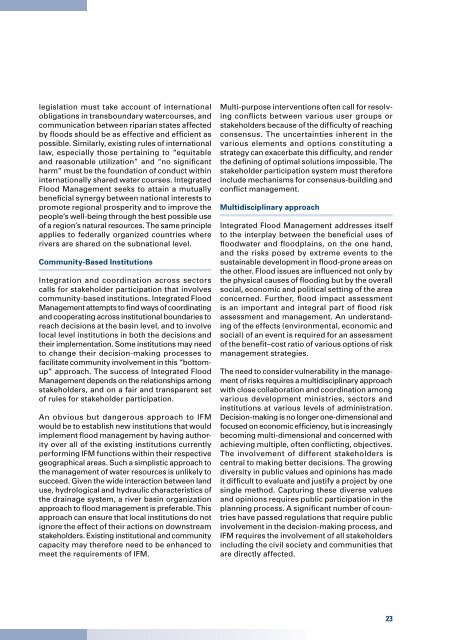Integrated Flood Management-Concept Paper.pdf - APFM
Integrated Flood Management-Concept Paper.pdf - APFM
Integrated Flood Management-Concept Paper.pdf - APFM
You also want an ePaper? Increase the reach of your titles
YUMPU automatically turns print PDFs into web optimized ePapers that Google loves.
legislation must take account of international<br />
obligations in transboundary watercourses, and<br />
communication between riparian states affected<br />
by floods should be as effective and efficient as<br />
possible. Similarly, existing rules of international<br />
law, especially those pertaining to “equitable<br />
and reasonable utilization” and “no significant<br />
harm” must be the foundation of conduct within<br />
internationally shared water courses. <strong>Integrated</strong><br />
<strong>Flood</strong> <strong>Management</strong> seeks to attain a mutually<br />
beneficial synergy between national interests to<br />
promote regional prosperity and to improve the<br />
people’s well-being through the best possible use<br />
of a region’s natural resources. The same principle<br />
applies to federally organized countries where<br />
rivers are shared on the subnational level.<br />
Community-Based Institutions<br />
Integration and coordination across sectors<br />
calls for stakeholder participation that involves<br />
community-based institutions. <strong>Integrated</strong> <strong>Flood</strong><br />
<strong>Management</strong> attempts to find ways of coordinating<br />
and cooperating across institutional boundaries to<br />
reach decisions at the basin level, and to involve<br />
local level institutions in both the decisions and<br />
their implementation. Some institutions may need<br />
to change their decision-making processes to<br />
facilitate community involvement in this “bottomup”<br />
approach. The success of <strong>Integrated</strong> <strong>Flood</strong><br />
<strong>Management</strong> depends on the relationships among<br />
stakeholders, and on a fair and transparent set<br />
of rules for stakeholder participation.<br />
An obvious but dangerous approach to IFM<br />
would be to establish new institutions that would<br />
implement flood management by having authority<br />
over all of the existing institutions currently<br />
performing IFM functions within their respective<br />
geographical areas. Such a simplistic approach to<br />
the management of water resources is unlikely to<br />
succeed. Given the wide interaction between land<br />
use, hydrological and hydraulic characteristics of<br />
the drainage system, a river basin organization<br />
approach to flood management is preferable. This<br />
approach can ensure that local institutions do not<br />
ignore the effect of their actions on downstream<br />
stakeholders. Existing institutional and community<br />
capacity may therefore need to be enhanced to<br />
meet the requirements of IFM.<br />
Multi-purpose interventions often call for resolving<br />
conflicts between various user groups or<br />
stakeholders because of the difficulty of reaching<br />
consensus. The uncertainties inherent in the<br />
various elements and options constituting a<br />
strategy can exacerbate this difficulty, and render<br />
the defining of optimal solutions impossible. The<br />
stakeholder participation system must therefore<br />
include mechanisms for consensus-building and<br />
conflict management.<br />
Multidisciplinary approach<br />
<strong>Integrated</strong> <strong>Flood</strong> <strong>Management</strong> addresses itself<br />
to the interplay between the beneficial uses of<br />
floodwater and floodplains, on the one hand,<br />
and the risks posed by extreme events to the<br />
sustainable development in flood-prone areas on<br />
the other. <strong>Flood</strong> issues are influenced not only by<br />
the physical causes of flooding but by the overall<br />
social, economic and political setting of the area<br />
concerned. Further, flood impact assessment<br />
is an important and integral part of flood risk<br />
assessment and management. An understanding<br />
of the effects (environmental, economic and<br />
social) of an event is required for an assessment<br />
of the benefit–cost ratio of various options of risk<br />
management strategies.<br />
The need to consider vulnerability in the management<br />
of risks requires a multidisciplinary approach<br />
with close collaboration and coordination among<br />
various development ministries, sectors and<br />
institutions at various levels of administration.<br />
Decision-making is no longer one-dimensional and<br />
focused on economic efficiency, but is increasingly<br />
becoming multi-dimensional and concerned with<br />
achieving multiple, often conflicting, objectives.<br />
The involvement of different stakeholders is<br />
central to making better decisions. The growing<br />
diversity in public values and opinions has made<br />
it difficult to evaluate and justify a project by one<br />
single method. Capturing these diverse values<br />
and opinions requires public participation in the<br />
planning process. A significant number of countries<br />
have passed regulations that require public<br />
involvement in the decision-making process, and<br />
IFM requires the involvement of all stakeholders<br />
including the civil society and communities that<br />
are directly affected.<br />
23
















